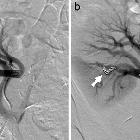renal arteriovenous fistula













Renal arteriovenous fistulae (AVFs) are anomalous direct communications between arteries and veins in the kidney, which may be confused with a renal arteriovenous malformation (rAVM).
Epidemiology
The incidence of renal AVF is variable, estimated at 0.3-19% in native kidneys and 6-8% in renal transplants . Approximately 70% of cases are acquired or iatrogenic, while about 20% are congenital .
Clinical presentation
The majority of renal AVFs are asymptomatic . However, it can present with flank pain, gross hematuria, acute urinary retention, hypertension, high output cardiac failure, renal insufficiency, massive hemorrhage or thromboembolic phenomena . At physical examination, continuous abdominal bruit or palpable thrill may be present.
Pathology
Renal arteriovenous fistulae are usually acquired lesions, unlike renal AVMs which are frequently developmental abnormalities. The majority of cases are iatrogenic and occur as a complication of renal biopsy, nephrostomy, blunt or penetrating trauma, inflammation, malignancy, or renal surgery .A few cases of congenital AVFs have been documented and are thought to be present at birth or to result from a congenital aneurysm that erodes into the adjacent vein .
Radiographic features
Renal arteriovenous fistulae may mimic renal AVMs on imaging. Renal AVFs should be suspected when a history of image guided percutaneous renal biopsy is present.
Ultrasound
Renal AVFs are usually imperceptible in B-mode.
Color Doppler images depict a flash of color, “visible thrill” or “soft tissue bruit”, that results from the vibration of the soft tissue surrounding the renal AVF, producing a focal color mosaic overlying the adjacent soft tissue . Adjusting the color Doppler to higher velocities may show the feeding artery and the enlarged draining vein.
Spectral Doppler tracings show a high-velocity, low resistance flow within the artery and turbulent, pulsatile, arterialized flow in the segmental draining vein. If large, the main renal vein may have pulsatile flow.
CT
CT angiography may demonstrate the anomalous renal arteriovenous communication with associated aneurysms and early opacification of the renal vein on the arterial phase .
Treatment and prognosis
Renal AVFs usually resolve spontaneously. It may be treated whenever it is symptomatic, large or extrarenal . The therapeutic method of choice is endovascular intervention. Different technical methods of embolization are available . Surgical treatment is partial or total nephrectomy or arterial ligation .
Siehe auch:

 Assoziationen und Differentialdiagnosen zu arteriovenöse Fistel der Niere:
Assoziationen und Differentialdiagnosen zu arteriovenöse Fistel der Niere:

